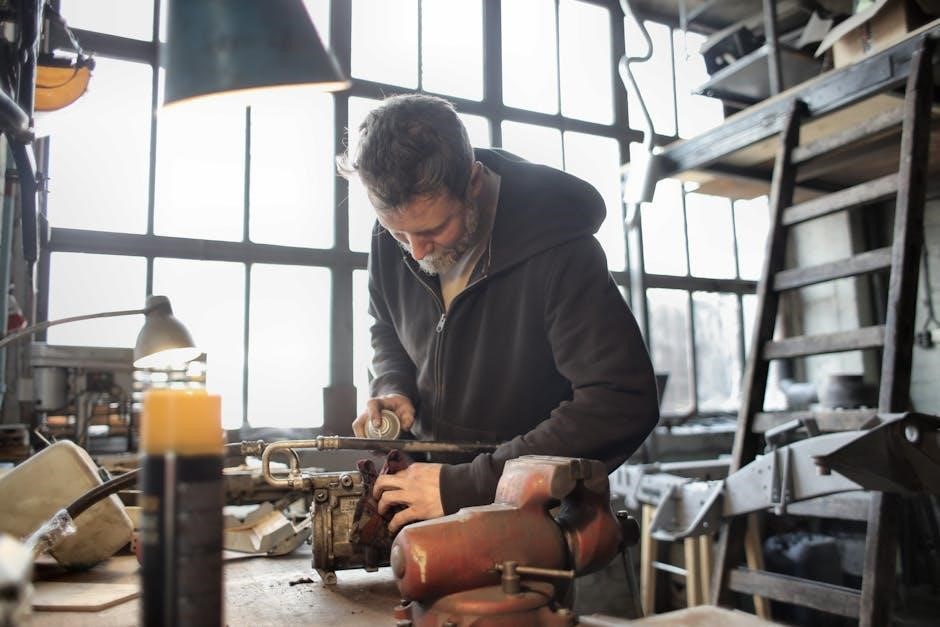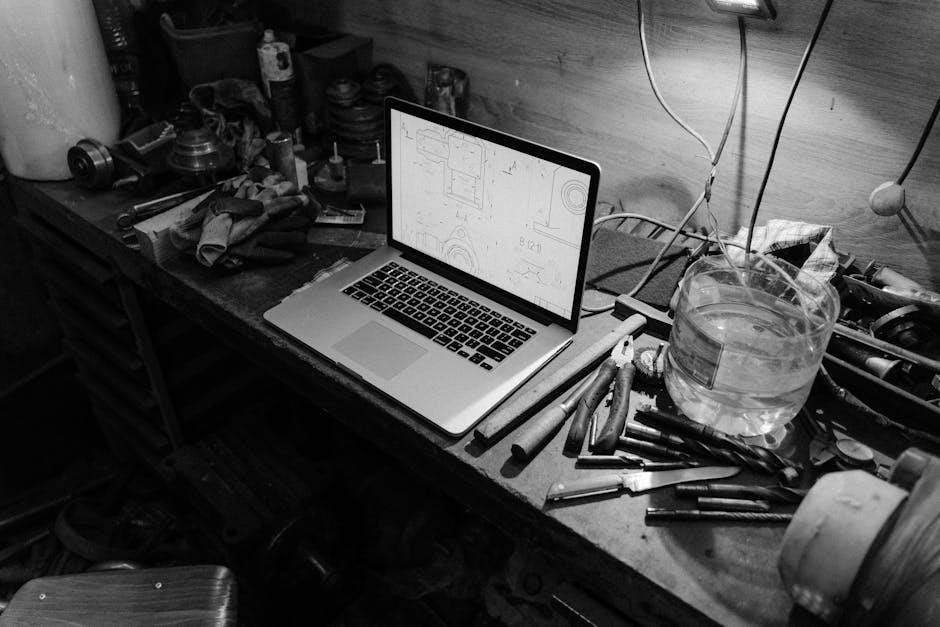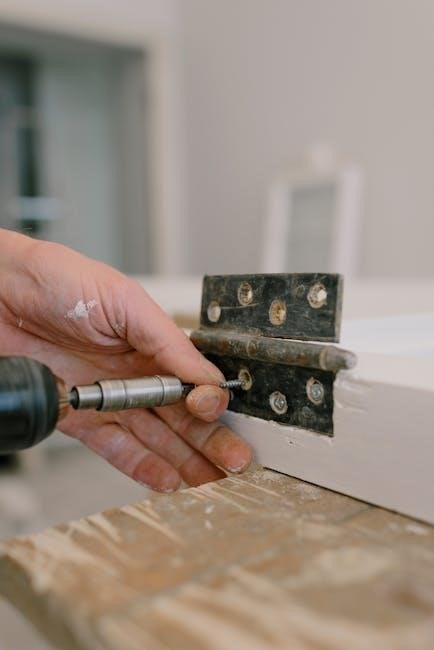Safety Precautions
Always disconnect the battery and ensure the RV is stable with wheel chocks before starting repairs. Wear protective gear and avoid overloading the slide-out mechanism. Keep children away from moving parts and never attempt repairs while the RV is in motion. Ensure proper grounding to prevent electrical shocks and follow the manufacturer’s safety guidelines meticulously.
Preparation Steps
Before starting any repairs, ensure the RV is on a level surface and stabilize it with wheel chocks. Disconnect the battery to prevent accidental motor activation. Engage the parking brake and turn off all power sources. If the slide-out is stuck, manually override the system by locating the override switch or crank, as specified in your owner’s manual. Inspect the slide-out tracks, gears, and moving parts for debris or damage. Lubricate all moving components to ensure smooth operation. Test the slide-out motor independently to identify if the issue is mechanical or electrical. Check the hydraulic pump and electrical connections for any signs of wear or corrosion. Consult the manufacturer’s manual for specific instructions and safety guidelines before proceeding with any repairs.
Emergency Procedures
In case of an emergency, such as a slide-out malfunctioning or becoming stuck, remain calm and follow these steps. First, disconnect the power supply and ensure the RV is stable. If the slide-out is stuck, attempt to manually override the system using the crank or release mechanism specified in your owner’s manual; Never force the slide-out to move, as this can cause further damage. Check for common issues like loose electrical connections, blown fuses, or hydraulic fluid leaks; If the motor is running but the slide-out doesn’t move, inspect the cables for disconnection or damage. For severe mechanical failures or electrical malfunctions, contact a professional immediately. Always prioritize safety and avoid operating the slide-out until the issue is resolved.

Understanding RV Slide-Out Mechanisms

RV slide-out mechanisms operate using hydraulic, electric, or manual systems to extend or retract living spaces. They rely on motors, gears, and control panels to function smoothly and safely.
Types of Systems
RV slide-out systems are categorized into three main types: hydraulic, electric, and manual. Hydraulic systems use fluid pressure to extend and retract, offering smooth operation and heavy-duty performance. Electric systems rely on motors and gears, providing quieter operation and easier maintenance. Manual systems require a crank or handle to move the slide-out, offering simplicity but more physical effort. Additionally, some RVs use cable-driven or pneumatic systems for lighter applications. Each type has specific mechanisms, such as gears, pistons, or cables, designed to handle varying weights and sizes of slide-outs. Understanding the system type is crucial for proper repair and maintenance, as methods vary significantly between hydraulic, electric, and manual configurations.
Key Components

The RV slide-out system comprises several essential components. The motor or actuator powers the movement, while gears and tracks ensure smooth operation. Hydraulic pumps and hoses are critical for hydraulic systems, providing the necessary fluid pressure. The control panel manages the electrical signals, and sensors monitor alignment and position. Pistons and cylinders convert hydraulic energy into mechanical motion, and cables or chains assist in manual systems. The slide-out room’s seals and weatherstripping prevent leaks, and stabilizing bars enhance structural integrity. Regular inspection of these components is vital for maintaining functionality and safety. Understanding each part’s role helps in diagnosing issues and performing effective repairs. Proper maintenance of these components ensures reliable operation and extends the lifespan of the slide-out system.

Troubleshooting Common Issues

Identify common issues like misalignment or power failure. Check the power supply, electrical connections, and fuses. Inspect hydraulic systems and test manual operation for smooth functionality.
Electrical Problems

Electrical issues are common in RV slide-outs, often due to bad ground connections or blown fuses. Over 90% of electrical problems stem from poor grounding. Always check the power supply, fuses, and breakers. Inspect wires for damage or corrosion and ensure all connections are tight. If the motor runs but the slide doesn’t move, cables may be detached. Test the motor independently and reset it if necessary. Use a multimeter to verify voltage at the motor and controller. Avoid overriding systems while powered on, as this can cause further damage. Disconnect the battery before making repairs to prevent shocks. Consult the manual for specific troubleshooting steps, and consider professional help if electrical problems persist or worsen. Proper maintenance and regular inspections can prevent many of these issues from arising.
Mechanical Issues
Mechanical problems with RV slide-outs often involve misalignment, worn gears, or debris in the tracks. Regular lubrication of moving parts, such as gears and tracks, can prevent many issues. Inspect for loose bolts or damaged components and tighten or replace them as needed. If the slide-out binds, check for obstructions like dirt or debris and clean the area thoroughly. Misaligned slides may require recalibration or adjustment of the motor. Manually overriding the system can help diagnose issues, but ensure the power is off before attempting this. Always refer to the manual for specific instructions. Worn-out parts, such as rollers or seals, should be replaced promptly to avoid further damage. Addressing mechanical issues early can prevent costly repairs and ensure smooth operation. Regular maintenance, including inspections and lubrication, is key to extending the lifespan of your RV slide-out system.
Alignment Problems
Alignment issues with RV slide-outs can cause uneven extension or retraction, leading to mechanical stress and potential damage. Signs of misalignment include the slide-out not moving smoothly, uneven gaps, or the room not sealing properly. To address this, start by ensuring the RV is on a level surface and stable. Manually check the slide-out’s alignment by observing its movement. If misaligned, refer to the manual for recalibration instructions, which may involve resetting the motor or adjusting the track. Disconnect the battery before attempting any manual adjustments. Severe misalignment may require professional realignment to prevent further damage. Regular inspections and proper maintenance can help prevent alignment issues, ensuring smooth operation and extending the lifespan of your RV slide-out system. Always prioritize safety when working on alignment corrections.

Maintenance Tips
Regularly lubricate moving parts, clean debris from tracks, and inspect for wear. Check electrical connections and ensure proper alignment to prevent damage and ensure smooth operation.
Lubrication and Care
Regular lubrication is essential to maintain smooth operation of RV slide-out mechanisms. Apply high-quality silicone-based lubricants to tracks, gears, and moving parts to reduce friction and prevent corrosion. Inspect and clean debris from tracks and rollers to ensure proper alignment and movement. Lubricate pivot points and hinges to avoid squeaking and wear. Use a grease gun for hard-to-reach areas and ensure all components are well-coated. Avoid using WD-40, as it can attract dust and dirt, leading to premature wear. Clean the slide-out seals with mild soap and water to prevent cracking and maintain a watertight seal. Regularly inspect cables and pulleys for fraying or damage and replace them if necessary. Lubricate the motor and hydraulic systems as recommended by the manufacturer to ensure optimal performance. Schedule annual maintenance to inspect and lubricate all components, ensuring reliable operation and extending the lifespan of your RV slide-out system.

Repair Approaches
Assess the issue, then choose between DIY fixes or professional service. For minor problems, use the manual for guidance. For complex issues, seek expert assistance to ensure safety and proper repairs.
DIY Fixes
For minor issues, DIY fixes can be effective. Start by tightening loose electrical connections and checking for blown fuses or tripped breakers. Lubricate tracks, gears, and moving parts to ensure smooth operation. If the slide-out is stuck, manually overriding the system may resolve the issue—refer to your owner’s manual for instructions. Inspect and clear debris from the mechanism, as dirt or obstructions can cause misalignment. For motor-related problems, test the slide-out independently to isolate the fault. Re-syncing the motors and recalibrating the system are also manageable DIY tasks. Always disconnect the battery before attempting repairs and ensure the RV is stable. While DIY fixes can save time and money, avoid overloading the system and consult a professional if issues persist or require advanced expertise.
When to Call a Professional
There are several scenarios where it’s advisable to seek professional help for RV slide-out repairs. If the issue involves complex motor or hydraulic system problems, it’s best to consult a professional to avoid further damage or safety risks. Electrical system issues, especially those involving bad ground connections, should also be handled by experts to prevent potential hazards like shocks or fires. Alignment problems that persist after DIY attempts require professional realignment to prevent additional stress on the mechanism. Major mechanical issues, such as broken gears or damaged tracks, necessitate professional intervention to ensure proper repair. If DIY fixes fail to resolve the issue or if there’s a lack of confidence in diagnosing the problem, a professional’s expertise is crucial. Finally, after an accident or significant impact affecting the slide-out, a professional assessment is essential to evaluate and repair any damage safely and effectively.

Preventative Measures
Regularly lubricate moving parts, check electrical connections, and inspect for damage or misalignment. Schedule professional maintenance annually and follow manufacturer guidelines to prevent future issues.
Tips for Avoiding Repairs
Tips for Avoiding Repairs
To prevent costly repairs, regular maintenance is crucial. Lubricate tracks, gears, and moving parts annually to ensure smooth operation. Inspect electrical connections and tighten them if necessary. Check for proper alignment of the slide-out mechanism and address any misalignment promptly. Clean and remove debris from tracks and seals to prevent jamming. Regularly inspect hydraulic lines and motors for leaks or damage. Ensure the system is properly grounded to avoid electrical issues. Follow the manufacturer’s maintenance schedule and guidelines. Avoid overloading the slide-out beyond its recommended capacity. Store the RV with the slide-outs retracted to protect them from weather damage. By adhering to these tips, you can significantly reduce the likelihood of mechanical or electrical failures and extend the lifespan of your RV slide-out system.




